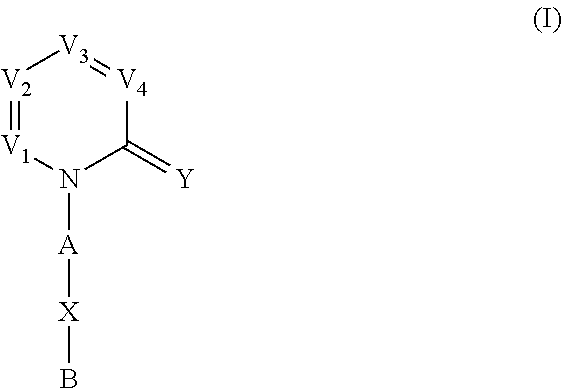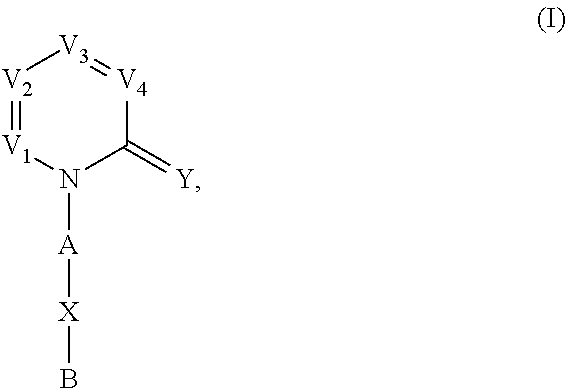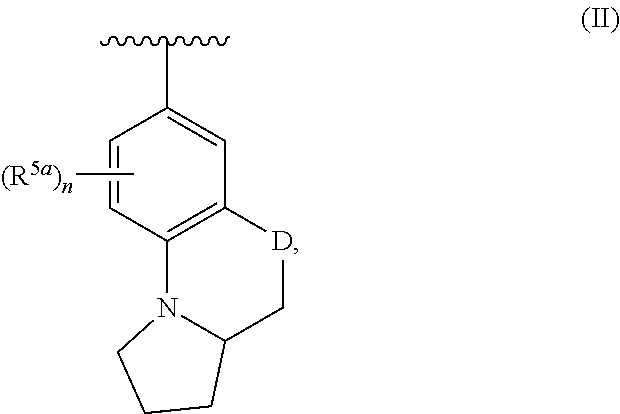Nitrogenous heterocyclic derivatives and their application in drugs
a technology of nitrogenous heterocyclic compounds and derivatives, applied in the field of medicine, can solve problems such as tissue damage and organ scarring
- Summary
- Abstract
- Description
- Claims
- Application Information
AI Technical Summary
Benefits of technology
Problems solved by technology
Method used
Image
Examples
example 1
1-(3-fluoro-4-(morpholinomethyl)phenyl)-5-methylpyridin-2(1H)-one
[0528]
Step 1) 4-(2-fluoro-4-iodobenzyl)morpholine
[0529]To a solution of 2-fluoro-4-iodotoluene (23.60 g, 0.10 mol) in CHCl3 (1000 mL) was added BPO (0.55 g, 2.27 mmol) and NBS (24.92 g, 0.14 mol) under N2. The reaction mixture was refluxed for 6 h, then cooled and filtered. The filtrate was concentrated in vacuo. The residue was added to a solution of morpholine (43.56 g, 0.50 mol) in EtOH (1000 mL) under N2. The resulting mixture was stirred at rt overnight, and concentrated in vacuo. The residue was purified by a silica gel column chromatography (PE / EtOAc (V / V)=3:1) to give the title compound as a white solid (4.82 g, 15%).
Step 2) 1-(3-fluoro-4-(morpholinomethyl)phenyl)-5-methylpyridin-2(1H)-one
[0530]A mixture of CuI (0.19 g, 1 mmol), Cs2CO3 (6.85 g, 20 mmol) and ethyl 2-oxocyclohexanecarboxylate (0.34 g, 2 mmol) in DMSO (10 mL) was stirred at rt for 30 min under N2. Then to the reaction mixture was added a solution ...
example 2
1-(3-fluoro-4-(morpholinomethyl)phenyl)-3,5-dimethylpyridin-2(1H)-one
[0533]
[0534]A mixture of 3,5-dimethylpyridin-2(1H)-one (0.22 g, 1.80 mmol), 4-(2-fluoro-4-iodobenzyl)morpholine (0.58 g, 1.80 mmol), K2CO3 (2.48 g, 18 mmol), CuI (0.02 g, 0.1 mmol) and DMF (3 mL) was refluxed under N2. The reaction process was monitored by TLC. The reaction mixture was cooled to rt and filtered. To the filtrate was added H2O (10 mL) and CH2Cl2 (20 mL). The CH2Cl2 layer was separated, and the aqueous layer was extracted with CH2Cl2 (20 mL×2). The combined organic phases were dried over Na2SO4 and concentrated in vacuo. The residue was purified by a silica gel column chromatography (PE / EtOAc (V / V)=1:1) to give the title compound as a white solid (0.28 g, 50%). The compound was characterized by the following spectroscopic data:
[0535]MS (ESI, pos.ion) m / z: 317.1 (M+1);
[0536]1H-NMR (400 MHz, CDCl3): δ 2.06 (s, 3H), 2.16 (s, 3H), 2.61 (s, 2H), 4.10 (m, 4H), 4.32 (m, 4H), 6.97 (s, 1H), 7.09 (s, 1H), 7.24 ...
example 3
1-(3-fluoro-4-((4-methylpiperazin-1-yl)methyl)phenyl)-3,5-dimethylpyridin-2(1H)-one
[0537]
Step 1) 1-(2-fluoro-4-iodobenzyl)-4-methylpiperazine
[0538]To a mixture of 2-fluoro-4-iodotoluene (0.94 g, 4.0 mmol) in CCl4 (40 mL) were added BPO (0.02 g, 0.08 mmol) and NBS (0.78 g, 4.4 mmol) under N2. The reaction mixture was refluxed for 5 h, then cooled and concentrated in vacuo. To the residue was added a solution of methylpiperazine (2.00 g, 20 mmol) in EtOH (40 mL) under N2. The mixture was stirred at rt overnight and concentrated in vacuo. The resulting residue was purified by a silica gel column chromatography (PE / EtOAc (V / V)=10:1) to give the title compound as a white solid (0.69 g, 52%).
Step 2) 1-(3-fluoro-4-((4-methylpiperazin-1-yl)methyl)phenyl)-3,5-dimethyl pyridin-2(1H)-one
[0539]A mixture of 3,5-dimethylpyridin-2(1H)-one (0.07 g, 0.57 mmol), 1-(2-fluoro-4-iodobenzyl)-4-methylpiperazine (0.19 g, 0.57 mmol), K2CO3 (0.08 g, 0.58 mmol), CuI (0.005 g, 0.026 mmol) and DMF (1 mL) was re...
PUM
| Property | Measurement | Unit |
|---|---|---|
| Temperature | aaaaa | aaaaa |
| flow rate | aaaaa | aaaaa |
| wavelength | aaaaa | aaaaa |
Abstract
Description
Claims
Application Information
 Login to View More
Login to View More - R&D
- Intellectual Property
- Life Sciences
- Materials
- Tech Scout
- Unparalleled Data Quality
- Higher Quality Content
- 60% Fewer Hallucinations
Browse by: Latest US Patents, China's latest patents, Technical Efficacy Thesaurus, Application Domain, Technology Topic, Popular Technical Reports.
© 2025 PatSnap. All rights reserved.Legal|Privacy policy|Modern Slavery Act Transparency Statement|Sitemap|About US| Contact US: help@patsnap.com



